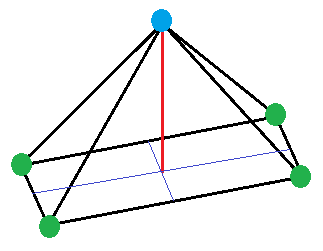MENSURATION OF SOLID SHAPES
Properties of solid shapes
a) A Cube
A cube has the following properties.
- It has 12 straight edges
- It has 8 vertices
- It also has 6 square faces
- Its net consists of 6 square faces joined together
b) A Cuboid

A cuboid has the following properties.
- It has 12 straight edges
- It has 8 vertices
- It also has 6 rectangular faces
- Its net consist of 6 rectangular faces
c) A Triangular Prism

A triangular prism has the following properties:
- It has 6 vertices
- It has 9 straight edges
- It also has 3 rectangular faces and two triangular faces which are the end faces
- Its net consist of 3 rectangles and 2 triangles joined together
d) A Cylinder

Properties:
- A cylinder has 2 circular faces
- It has 1 curved surface
- It has 2 curved edges
- Its net consist of two circular faces and 1 rectangular face i.e its net consist of 2 circles and 1 rectangle.
A Cone

- It has one vertex
- It has 2 curved edges
- It has 1 curved surface
- It also has 1 circular face
- Its net consist of a sector of a circle and a circle
f) Rectangular based pyramids

A rectangular based pyramid has the following properties:
- It has 8 straight edges
- It has 5 vertices
- It has 4 triangular faces
- It has 1 rectangular face
- Its net consists of 4 triangles and 1 rectangle
EVALUATION
- (a) Mention and draw 3 solid shapes that you know
(b) Write down the properties of each of the solid shapes you mentioned in 1a above
(c) List one real object for each of the solid shape mentioned in (1a) above
Surface Area and Volume of Common Solid shapes
A prism is a solid which has uniform cross section. Cubes, cuboids, and cylinders are examples of prisms. In general,
Volume of prism = area of uniform cross section X perpendicular height
=area of base x height
Cube
Volume = l3
Surface area = 6l2
Cuboid
Volume =lbh
Surface area = 2 (lb + lh + bh)
Cylinder
Volume = πr2 h
Curved surface area = 2πrh
Total surface area = 2πrh + 2π r2
= 2πr ( h + r)
EVALUATION
1a. A rectangular tank is 76cm long, 50cm wide and 40 cm high. How many litres of water can it hold?
b. Calculate the total surface area of the rectangular tank in question 1a above
Volume of Pyramids and Volume of cone
In general,
Volume = 1/3 x base area x height
EVALUATION
1. A cone of height 9cm has a volume of n cm3 and a curved surface area of n cm3. Find the vertical angle of the cone
2. A right pyramid on a base 8cm square has a slant edge of 6cm. Calculate the volume of the pyramid
GENERAL EVALUATION
- A solid cone has a circular base of radius 7cm. the vertical height of the cone is 15cm. the cone is melted and recast into a metal cube of side xcm. Calculate correct to 3.s.f. the value of x.
- A cylindrical container with a diameter 80cm and height 50cm is full of liquid. The liquid is then poured into another cylinder with a diameter 90cm. calculate the depth of the water.
READING ASSIGNMENT
NGM SS Bk 1 pg 166- 170 Ex 15a Nos 1 (d), 1(f), 2(b) and 29c) pages 168 -169.
WEEKEND ASSIGNMENT
- Calculate the volume of a cylinder which has a radius of 21cm and height 6cm. A. 8500cm3 B. 8316cm3 C. 7632cm3 D 7500cm3 E. 8000cm3
- Calculate the total surface of the cylinder in question 1. A, 5346cm2 B, 4653cm3 C. 3000cm2 D. 3564 cm2 E 3800cm2
- Calculate the volume of a cone which has a base diameter of 7cm and a height of 6cm A. 77cm3 B. 70cm3 C. 88cm3 D. 90cm3 E. 65cm3
- Calculate the curved surface area of the cone in question 3 above. A, 152cm2 B. 150cm2 C. 132cm2 D 142cm2 E. 160cm2
- Calculate the total surface area of a cuboids which is 8cm by 5cm by 3cm. A.198cm2 B. 178cm2 C 188cm2 D 168cm2 E. 158cm2.
THEORY
- A water tank is 1.2m square and 1.35m deep. It is half full of water . How many times can a 9 litre bucket be filled from the tank?
- A measuring cylinder of radius 3cm contains water to a height of 49cm. If this water is poured into a similar cylinder of radius 7cm, what will be the height of the water column?.
Read our disclaimer.
AD: Take Free online baptism course: Preachi.com 